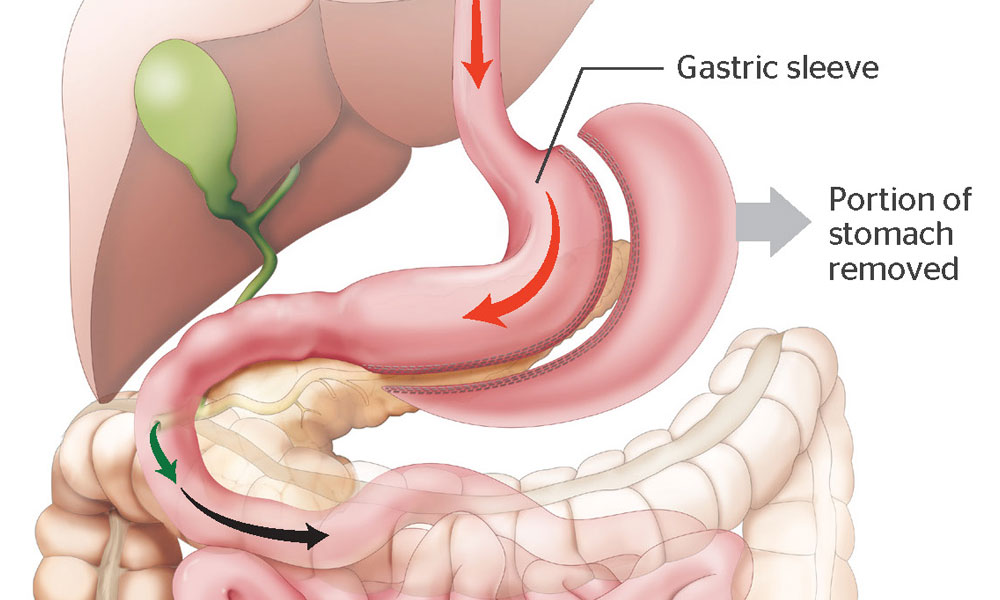Sleeve Gastrectomy

Laparoscopic Sleeve Gastrectomy
What is sleeve gastrectomy?
Sleeve Gastrectomy is an operation where the bulk of the stomach is removed, leaving a slender ‘sleeve’ of stomach in place. It is generally performed laparoscopically (through keyhole surgery). This surgery has low complication rates and patients can usually expect a comparably quick recovery.
How does sleeve gastrectomy work?
Most diets fail because they involve eating less which makes us feel hungry. Sleeve Gastrectomy helps by making a person feel full with only a small amount of food.
When we eat solid food it travels from the mouth down the oesophagus to the stomach where it is stored for a period of time. The stomach slowly breaks the solid food up and passes it across the Pylorus (which acts as a valve) into the intestine where nutrients are absorbed. While the food sits in the stomach it stretches it and this causes messages to be sent via nerves and hormones to the brain telling us that we are full. By taking most of the bulbous part of the stomach away less food is needed to stretch the stomach and in turn send the ‘full’ message to the brain. Sleeve gastrectomy also works by physically restricting the amount you can eat at any one time though this should not be relied on as forcible eating can stretch the sleeve up over time.
Important note: Sleeve Gastrectomy is only one part of achieving weight loss and better health; it needs to be incorporated into making healthy lifestyle and diet changes. Because you will eventually be able to eat normal foods yet feel full after a small amount, you will feel good, making healthy lifestyle and diet changes both successful and sustainable.
- General anaesthesia is administered by the Anaesthetist
- Keyhole incisions (usually five) are made and instruments placed into the abdomen
- A sizing tube is passed from the mouth to the stomach to gauge the size of the sleeve
- A series of staples are fired along the stomach to make the tube and simultaneously remove the bulk of the stomach
- The resected part of the stomach is removed, a drain is placed and incisions closed
- The patient is woken and transferred to the recovery area. Time in the operating theatre is usually around two hours.
Major complications are uncommon following Sleeve Gastrectomy. Many people don’t like to dwell on the negative though it is important you understand the major risks in order to make the best decision for yourself.
The main risk for Sleeve Gastrectomy is developing a leak along where the excess stomach has been stapled off. It occurs on average in 2.4% of patients. If a leak occurs you may need further surgery, ICU cares and even transference to a different hospital. It can take many weeks to recover from and most of the deaths reported following Sleeve Gastrectomy have occurred after a leak developed.
Other risks include:
- Internal bleeding
- Wound infection or abscess formation
- Stricture (excessive narrowing) of the stomach
- Injury to the spleen (sits very close to part of the stomach)
- Pulmonary embolism
- Wound site hernia
- Formation of gallstones
- Lung failure
- Kidney failure
- Death
Sleeve Gastrectomy offers many advantages over other weight loss operations, including (but not limited to):
- Stomach volume is reduced in size, but it functions normally so you will eventually be able to eat normal foods though in smaller quantities
- Minimises the chance of an ulcer occurring in the stomach
- Only a small risk of bowel blockage or vomiting from a blocked stomach
- Much less risk of food intolerance than after a gastric band
- Very effective as a first stage procedure for high BMI patients (BMI >55 kg/m2)
- Can be performed via keyhole surgery (much more easily than the gastric bypass)
- Short hospital stay
- Early return to work
- Less pain than for open surgery (large cut necessary)
- Fewer long-term complications than either Band or Bypass
Compared to other weight loss operations, some of the disadvantages of Sleeve Gastrectomy include:
- It is not reversible. Because the stomach is partly removed, it cannot be replaced. This operation is for life!
- Because this procedure is fairly new, the long-term outcomes are less well known. All currently available surgeries for weight loss are associated with late regain of a small proportion of the weight lost. Small studies suggest Sleeve Gastrectomy has similar rates to other operations though this is not well established
- Patients with a very high BMI to begin with may need further surgery if weight loss is inadequate. As with all the restrictive types of operations, soft foods and fluids that are high in calories are not restricted and inadequate weight loss may result. Foods such as ice cream, cheeses, dips, soft drinks and chocolate must be taken sparingly
- Because part of the stomach needs to be removed, the stomach that is left must be closed. This is done with a stapling instrument. Because of this closure there is a risk of holes occurring where it has been stapled. This is termed a ‘leak’ and can have a large impact on your recovery.
Discuss any concerns you may have with your doctor or specialist
